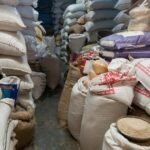OVERVIEW
The market for seed treatment is expected to reach USD 14.9 billion by 2025, rising at CAGR 9.75% over the forecast period. Owing to the growing demand for integrated pest management practices to reduce the use of pesticides, seed treatment products have gained popularity for their beneficial features such as the ability to fight diseases and pests in the early season and their effect on crop yield.








TABLE OF CONTENT
1 Global Seed Treatment Market
1.1 Study Objectives
1.2 Market Definition
1.3 Study Scope
1.3.1 Markets Covered
1.3.2 Geographic Scope
2 RESEARCH METHODOLOGY
2.1 Research Data
2.1.1 Secondary Data
2.1.1.1 Key Data From Secondary Sources
2.1.2 Primary Data
2.1.2.1 Key Data From Primary Sources
2.1.2.2 Key Industry Insights
2.1.2.3 Breakdown of Primaries
2.2 Market Size Estimation
2.2.1 Bottom-Up Approach
2.2.2 Top-Down Approach
2.3 Market Breakdown and Data Triangulation
2.4 Research Assumptions
3 Global Seed Treatment Market – Executive Summary
3.1 Market Revenue, Market Size and Key Trends by Company
3.2 Key Trends by type of Application
3.3 Key Trends segmented by Geography
4 Global Seed Treatment Market – Comparative Analysis
4.1 Product Benchmarking – Top 10 companies
4.2 Top 5 Financials Analysis
4.3 Market Value split by Top 10 companies
4.4 Patent Analysis – Top 10 companies
4.5 Pricing Analysis
5 Global Seed Treatment Market – Industry Market Entry Scenario
5.1 Regulatory Framework Overview
5.2 New Business and Ease of Doing business index
5.3 Case studies of successful ventures
5.4 Customer Analysis – Top 10 companies
6 Global Seed Treatment Market – Market Forces
6.1 Introduction
6.2 Market Dynamics
6.2.1 Drivers
6.2.2 Opportunities
6.2.3 Challenges
6.3 Porters Analysis of Market
6.3.1 Bargaining power of suppliers
6.3.2 Bargaining powers of customers
6.3.3 Threat of new entrants
6.3.4 Rivalry among existing players
6.3.5 Threat of substitutes
7 Global Seed Treatment Market – Strategic Analysis
7.1 Value Chain analysis
7.2 Product Life Cycle
7.3 Supplier and distributor analysis (Market share and product dealing strategies)
8 Global Seed Treatment Market – By Type (Market Size – & million/billion)
8.1 Chemical seed treatment
8.2 Non-chemical seed treatment
9 Global Seed Treatment Market – By Function
9.1 Imidacloprid
9.2 Thiamethoxam
9.3 Seed protection
9.4 Thiram
9.5 Carbendazim
9.6 Tebuconazole
9.7 Carboxin
9.8 Clothianidin
9.9 Seed enhancement
9.10 Others
10 Global Seed Treatment Market – By Type
10.1 Cereals & grains
10.2 Oilseeds & pulses
10.3 Other
11 Global Seed Treatment Market – By Application Technique
11.1 Seed coating
11.2 Seed dressing
11.3 Seed pelleting
12 Global Seed Treatment Market – By Geography (Market Size – & million/billion)
12.1 Introduction
12.2 North America
12.2.1 US
12.2.2 Canada
12.2.3 Mexico
12.3 Europe
12.3.1 U.K
12.3.2 Germany
12.3.3 Italy
12.3.4 France
12.3.5 Spain
12.3.6 Rest of Europe
12.4 Asia-Pacific
12.4.1 China
12.4.2 Japan
12.4.3 India
12.4.4 South Korea
12.4.5 Rest of APAC
12.5 Rest of the World
12.5.1 South America
12.5.2 Middle East
12.5.3 Africa
13 Global Seed Treatment Market – Entropy
13.1 New product launches
13.2 M&A’s, collaborations, JVs and partnerships
14 Global Seed Treatment Market Company Profile (Key Players)
14.1 Market Share, Company Revenue, Products, M&A, Developments
14.2 Bayer
14.3 Syngenta
14.4 BASF
14.5 FMC
14.6 Arysta Lifescience
14.7 Sumitomo Chemical
14.8 DOW Agrosciences
14.9 Dupont
14.10 Monsanto
14.11 Nufarm
14.12 Company 11 & more
15 Global Seed Treatment Market – Appendix
15.1 Sources
15.2 Abbreviations













